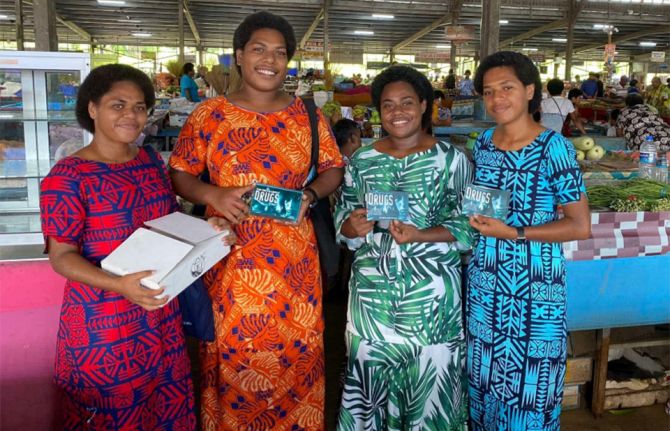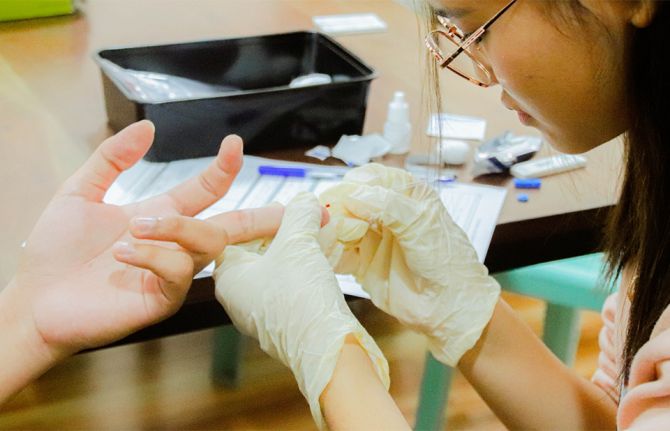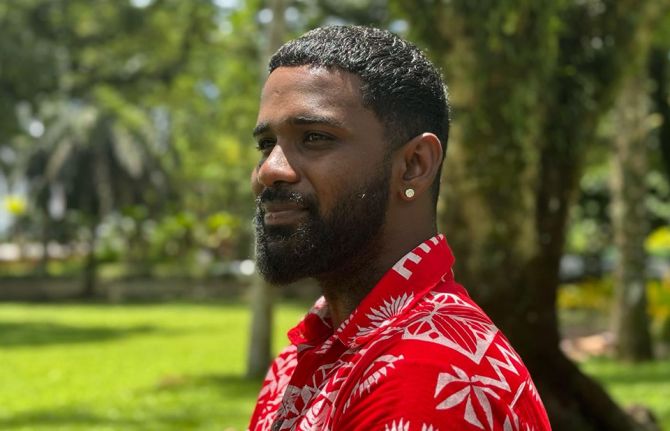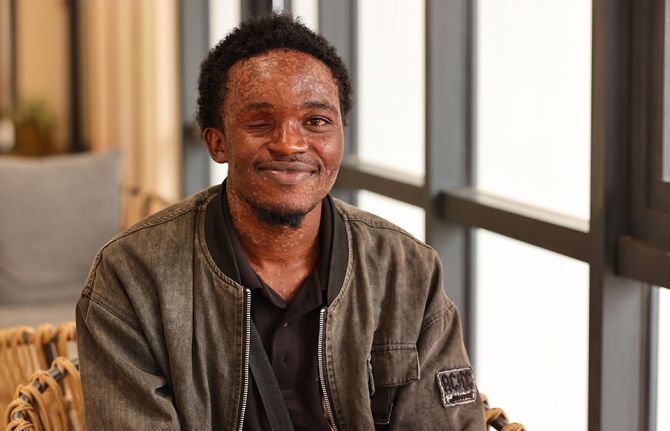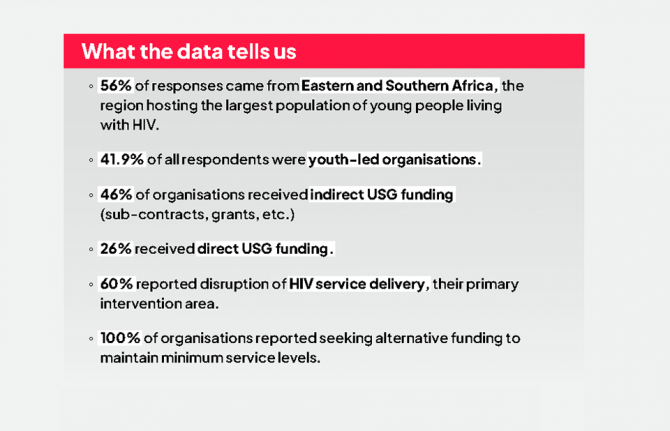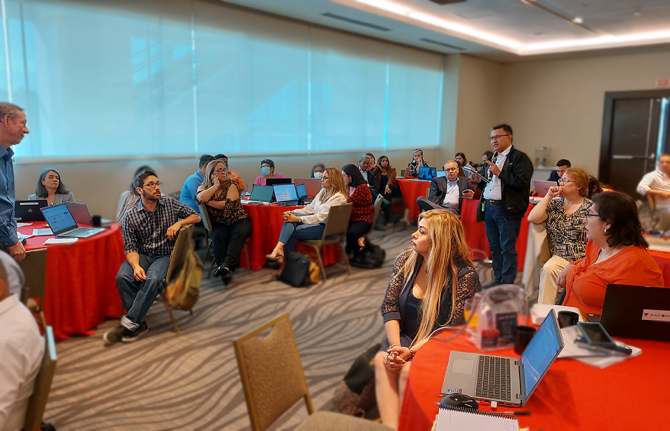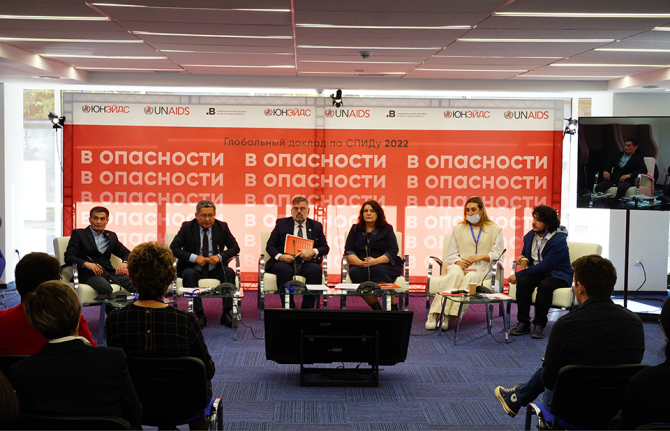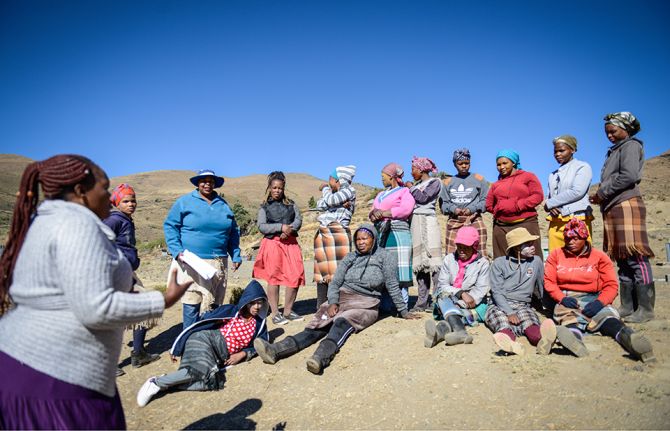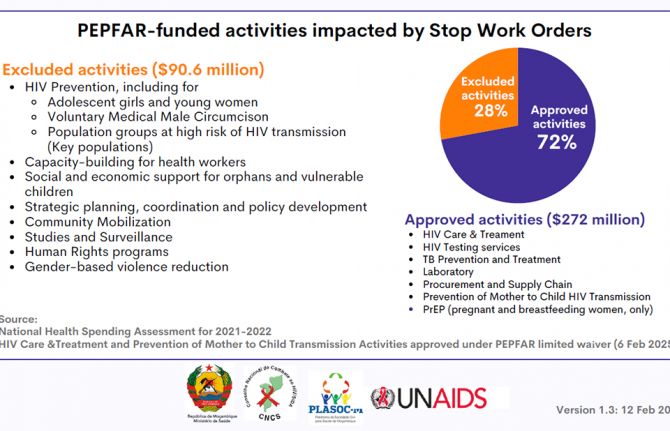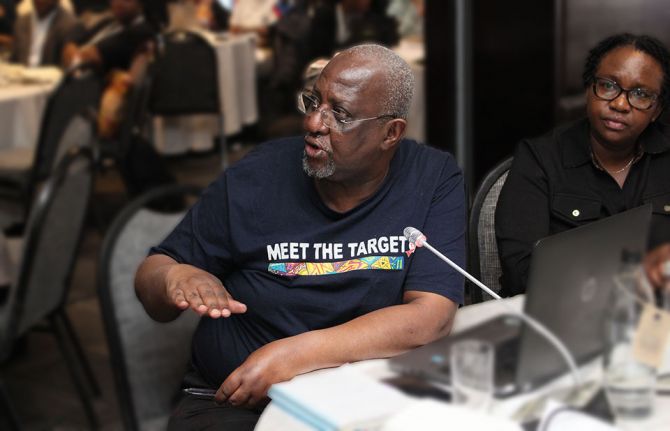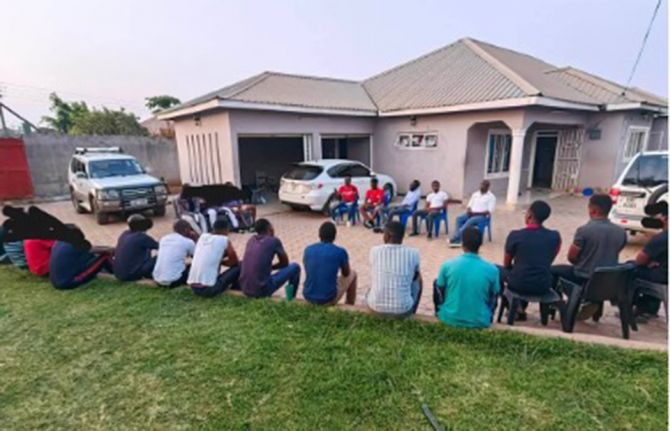
Feature Story
Cricket chief and star show AIDS solidarity in India
04 September 2007
04 September 2007 04 September 2007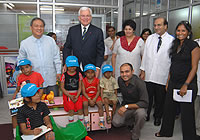
ICC chief Malcolm Speed (standing in centre),
cricketer Virender Sehwag (crouching) and
UNICEF Representative Cecilio Adorna (left)
with childrenand staff at the Kalawati Saran
Children’s Hospital in New Delhi.
Photo credits: UNICEF India/2007/Biswas
Head of the International Cricket Council (ICC), Malcolm Speed joined Indian star Virender Sehwag and Cecilio Adorna, UNICEF India country representative, in a visit to the Antiretroviral treatment centre of the Kalawati Saran Children’s Hospital in New Delhi at the end of August. The visit was part of the ICC's partnership with UNAIDS and UNICEF to raise awareness and reduce stigma around AIDS and the impact of AIDS on children through the global campaign, UNITE FOR CHILDREN UNITE AGAINST AIDS .
As well as playing an impromptu game of cricket with a group of young children, the delegation also had the opportunity to meet with children and mothers living with HIV.
“Cricket is not all about the game,” said Malcolm Speed. “Having a social awareness programme associated with it is not only an excellent way to reach out to the cricket fans but also an uplifting experience for the cricketers as well, and puts everything into perspective,” he added.
Virenda Sehwag added: “It is important for every one of us to spend time children living with HIV. It is a pleasure to be associated with the cause. When celebrities endorse a noble cause like this, it has more impact.”
In India, an estimated 70,000 children below the age of 15 are living with HIV. Worldwide, every day there are estimated to be nearly 1,800 new HIV infections in children under 15.
AIDS and young people will be a key theme of the upcoming ICC Twenty 20 World Championships being hosted by South Africa from 11 to 24 September as part of the unique partnership between the ICC, UNICEF, UNAIDS, the African Broadcast Media Partnership and the Kaiser Family Foundation, using the cricket tournament to draw attention to the impact of AIDS on the world’s children.
Links:
Watch video footage of Malcolm Speed’s visit to the Indian Children’s hospital | High | Low
Read more on the ICC Twenty20 World Championships
Read more on Unite for Children: Unite against AIDS

Feature Story
Stars back AIDS awareness campaign at ICC World Twenty20 in South Africa
04 September 2007
04 September 2007 04 September 2007

The cricket World Twenty20 will focus
on children, young people and HIV.
Logo credits: ICC
International cricketers will highlight the situation of children and young people living with HIV as part of a far-reaching AIDS awareness campaign during the 2007 Twenty20 world cricket championship in South Africa.
Players, participating in the competition from 11 to 24 September in Johannesburg, will promote HIV prevention messages as part of the International Cricket Council's (ICC) ongoing partnership with UNAIDS and UNICEF.
Cricket fans will also be targeted by loveLife - South Africa's national youth HIV prevention programme - who are also partners in the initiative.
Top players, including South Africa captain Graeme Smith, Kumar Sangakkara of Sri Lanka and India's Yuvraj Singh will feature in public service announcements for the 'Unite for Children, Unite Against AIDS' campaign highlighting how HIV can affect the lives of young people. Broadcasters from 105 countries will be encouraged to use the messages that will be screened to fans on giant screens at the 27 matches during the tournament.
Other stars will visit UNICEF and loveLife community-based project activities in Cape Town, Durban and Johannesburg to promote AIDS awareness to young people and encourage them to develop life-skills to avoid HIV infection.
Players also plan to wear red ribbons in selected matches to demonstrate their support for people living with HIV.
Sri Lanka wicketkeeper-batsman Kumar Sangakkara said: "I hope people will listen to cricketers, I hope that our support helps and that it brings a different perspective to building interest in these issues and raising awareness. It's important to raise awareness any way that you can and if different voices and fresh faces help then that is good."
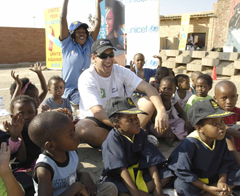
New Zealand cricketter Ross Taylor visiting
community-based project in South Africa.
Photo credits: ICC/Rebecca Hearfield
South Africa star AB de Villiers added: "I have a very soft heart and to see those children and the way they cope with HIV puts a lot of what I do as a cricketer in perspective. I have been involved in a few projects to do with 'Unite for Children, Unite Against AIDS' in different parts of the world where we have toured and it has been a very worthwhile thing to do.
"I feel a real calling to help wherever I can. The issue of AIDS is close to my heart because of the impact it has had on my country but I think we have a responsibility as high-profile sportsmen to do what we can as it helps to open eyes and it inspires people to do something about the problem. Awareness is a big factor in helping prevent the spread of HIV so the more we talk about it and keep it in the public eye the better."
India all-rounder Yuvraj Singh added: "Any social cause is important for top players playing any sport because people look up to you and you need to make them understand and educate them about issues relating to HIV. Through the ICC working with UNAIDS and UNICEF, we can deliver important messages to people all over the world."
Michael Hussey of Australia will also be supporting the campaign. He said: "When I visited an education project in the Caribbean during the ICC Cricket World Cup, I saw for myself the importance of educating young people on HIV and AIDS. UNICEF and UNAIDS play a vital role in addressing this epidemic and by supporting this partnership, by meeting young people and raising awareness of HIV and AIDS, I hope I can personally play a part in reducing discrimination."
As well as player-related activities, the 500 volunteers working at the event have all received HIV and AIDS education from loveLife health trainers, supported by UNAIDS. There will also be advertising boards at the grounds promoting the 'Unite for Children, Unite Against Aids' campaign.
The African Broadcast Media Partnership Against HIV/AIDS - a coalition of more than 50 African broadcast companies - will also be supporting the partnership, promoting player visits and event activities related to the partnership.
Cricket is popular in many of the countries that are most impacted by AIDS, including India and South Africa.
“UNAIDS has worked for many years with the ICC and the partnership has helped us reach large audiences with HIV prevention messages. Sport is a powerful force for change and the cricket players are great roles models helping us not only promote HIV prevention but also tackle the stigma and discrimination associated with HIV and AIDS,” said Andy Seale, team leader for civil society partnerships at UNAIDS.
Part of this story first appeared on the ICC web site: http://www.icc-cricket.com/
Links:
top cricketers talking about how children and young people are affected by HIV
Read feature story: Cricket chief and star show AIDS solidarity in India
Read more on the ICC Twenty20 World Championship
Read more on Unite for Children: Unite against AIDS
Related

Feature Story
The process behind AIDS estimates
30 August 2007
30 August 2007 30 August 2007Methodology explained
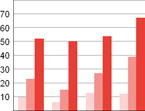
Knowing the status of the epidemic and monitoring the programmatic response are critical to understand where the epidemic is going and whether programmes are achieving desired impact. In order to Know the Epidemic, UNAIDS recommends the use of methodologies, tools and software which are regularly reviewed and adapted to respond to an evolving epidemic and changing needs.
Updated Q&Amp;A on HIV estimates
Improving national and regional estimates
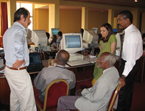
Between March and June 2007, national epidemiologists, analysts and heads of AIDS programmes from 124 countries have taken part in specialist UNAIDS training to improve and refine country HIV estimates.
Eleven regional training workshops have been conducted around the world to bring epidemiologists up to date with the latest developments in estimates tools and software packages including updated assumptions based on new evidence from research and added new features.
Results of recent population-based surveys

By mid 2007 a total of 26 countries in sub-Saharan Africa, two in the Caribbean and two in Asia had conducted nationally representative population-based surveys with HIV prevalence measurement. The results from these surveys are helping UNAIDS and goverments to refine and update AIDS estimates as new information becomes available.
2.5 million people living with HIV in India

As part of its continuous efforts to know its epidemic better, India’s National AIDS Control Organisation (NACO), supported by UNAIDS and WHO, have used improved data from more sources and revised the methodology used to analyse this new data to get a better understanding of the AIDS epidemic in India.
Related
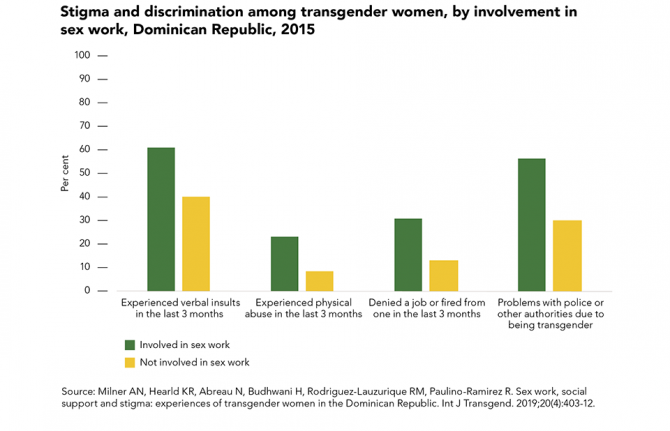 Transgender sex workers face frequent abuse
Transgender sex workers face frequent abuse

29 March 2022

Feature Story
Funding estimates for AIDS research and development
30 August 2007
30 August 2007 30 August 2007
The HIV Vaccines and Microbicides Resource
Tracking Working Group was created to generate
and disseminate high-quality, detailed and
comparable data on annual investments in
preventive HIV vaccine and microbicide research
and development
For a comprehensive response to AIDS, developing additional HIV prevention methods and tools to prevent HIV – such as HIV vaccines and microbicides -- is a key component.
The continuing research and development of such prevention technologies relies on adequate and efficient funding and spending – and supporting this, high quality, detailed data on investment in this area of the AIDS response is critical.
In 2004, UNAIDS, the Alliance for Microbicide Development (AMD), the AIDS Vaccine Advocacy Coalition (AVAC) and the International AIDS Vaccine Initiative (IAVI) established a collaborative project to track funding for HIV vaccines and microbicide research and development.
The HIV Vaccines and Microbicides Resource Tracking Working Group was created to generate and disseminate high-quality, detailed and comparable data on annual investments in preventive HIV vaccine and microbicide research and development and policy and advocacy activities. These data can be used to monitor current levels of effort; identify trends in investment, spending, and research focus; identify areas needing more resources and effort; assess the impact of public policies aimed at increasing investment in new prevention technologies; and provide a fact base for policy advocacy on research and development investments and allocations.
The collaboration aims to monitor progress in the implementation of the Declaration of Commitment on HIV/AIDS, adopted at the United Nations General Assembly Special Session (UNGASS) on HIV/AIDS in 2001. This declaration contains a number of global and national indicators that are being monitored on an annual basis by UNAIDS and others. The second of the global commitment and action indicators, is the “Amount of public funds available for research and development of vaccines and microbicides.”
In August 2007, the Working Group released a summary of the resource tracking efforts – the most up to date available data on sources of global funding and its allocation. These figures are produced to support larger resource needs estimations for the global AIDS response as a whole, which will be published in the later half of 2007
Among findings within the 2007 Working Group estimates on research and development are that while the current levels of funding are significant, there is a critical need to sustain and increase research and development investments for preventive vaccines, microbicides and other new options to optimally accelerate the development of and ensure eventual access to these HIV prevention tools.
As stated in the latest estimates report from the Working Group, in 2006, total global investment in preventive HIV-vaccine research and development was an estimated US$933 million, a 23% increase over 2005 funding levels. This increase in funding can primarily be attributed to new research initiatives funded through the US National Institutes of Health (NIH), Canada, the European Commission (EC) and the Bill & Melinda Gates Foundation.
However, financing needs are likely to remain substantial in the coming years, as funding is needed to explore new approaches to vaccine and microbicide design; bring novel candidates into the pipeline; support clinical trials to test the safety, immunogenicity and efficacy of new products; and translate research results, such as those for adult male circumcision, into policies and programmes.
“The HIV Vaccines and Microbicides Resource Tracking Working Group group has systematically documented the amount of financial resources needed and the actual expenditures from public sources in research and development. This is a notable example in the resource tracking world because of the good quality of its results combined with a very dynamic group that is able to translate the financial estimates into a powerful advocacy tool”, said Jose Antonio Izazola-Licea, UNAIDS Senior Adviser, Resource and Finance Analysis.
Links:
Read the full document on latest estimates on research and development investment and spending
Visit the Working Group's web site

Feature Story
UNAIDS Special Representative Mary Fisher visits Zambia
29 August 2007
29 August 2007 29 August 2007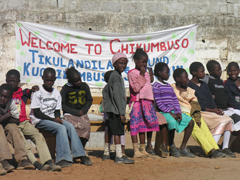
While in Lusaka, Ms. Fisher visited several shelters
for street children and vulnerable girls, including
Fountain of Hope and the Umoyo Training Centre.
As part of her work as UNAIDS Special Representative, AIDS activist, public speaker, author and artist Mary Fisher visited Lusaka, Zambia in August to promote AIDS awareness and increase support for various AIDS initiatives within the country. Traveling with a group of US-based health, business, and foundation leaders Mary visited sites throughout the capital, including a shelter for street children, a community school, and a training centre for young girls.
While in Lusaka, Ms. Fisher visited several shelters for street children and vulnerable girls, including Fountain of Hope and the Umoyo Training Centre. These organizations provide information on HIV, free health services, HIV prevention materials, and educational assistance to members of local communities.
At the Chikumbuso Women and Orphans project, Ms. Fisher and her colleagues joined single mothers and widows to find out more about their income-generating activities such as bracelet-making to support their families. Women at Chikumbuso also collect plastic grocery bags and weave them into purses and handbags that are sold at a weekly curio market in Lusaka. According to Ms. Fisher, the income generated from such a project “not only helps [the women] sustain themselves and their families, but provides a source of pride and hope.”

As part of her work as UNAIDS Special
Representative, Mary Fisher visited
Lusaka, Zambia to promote AIDS
awareness and increase support for
various AIDS initiatives within the
country. Photo credit: UNAIDS/M. Aon
As part of the mission, Ms Fisher also met with Maureen Mwanawasa, First Lady of Zambia and founder of the Maureen Mwanawasa Community Initiative at a State House event. During the event, the First Lady affirmed her support for Mary Fisher’s advocacy work and made it clear that Zambia’s political leaders are “committed to halting the spread of HIV”. As Chair of the Organisation of African First Ladies, and founder of its national chapter in Zambia, the Maureen Mwanawasa Community Initiative, Mrs. Mwanawasa has been particularly active in raising awareness and initiating programmes addressing HIV, not only in Zambia, but throughout Africa.
HIV prevalence rates in Zambia remain high at 18%, however the country has made significant progress in recent years, increasing the number of people receiving antiretroviral treatment and strengthening HIV prevention, treatment, care, and support programs in urban and rural areas.
Mary Fisher has been a UNAIDS Special Representative since May 2006. She works to raise awareness on HIV prevention, treatment, care and support with an emphasis on women and children. Fisher is also the founder the Mary Fisher Clinical AIDS Research and Education (CARE) Fund at the University of Alabama at Birmingham and is an active member of the leadership council of the Global Coalition on Women and AIDS.
Links:
More information on Mary Fisher's activities as a UNAIDS Special Representative

Feature Story
First association for people living with HIV in Pakistan
24 August 2007
24 August 2007 24 August 2007A new national initiative from UNAIDS in Pakistan aims to ensure that communities and the government listen to the experts - people living with HIV - when making decisions about treatment, care, support and prevention.
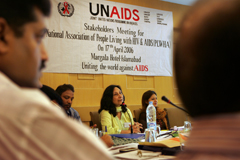
The association was launched on World AIDS Day
2006 with the support of UNAIDS and its UN
co-sponsors, and the Pakistan government.
Photo credit: UNAIDS / J. Moore
Twenty-four year old Masood is the newest recruit to one of UNAIDS’ latest initiatives: the“Association of People Living with HIV and AIDS in Pakistan”.
The association was launched on World AIDS Day 2006 with the support of UNAIDS and its UN co-sponsors, and the Pakistan government. The aim is to make sure that people living with HIV are consulted when decisions about prevention, treatment, care and support are taken at federal and provincial level.
In keeping with the principle of greater involvement of people living with HIV, all the executive board members of the association are HIV positive. Now, it is establishing the first network among people living with HIV in Pakistan to provide a platform for them to speak in unison.
“In my experience, most HIV positive people here have difficulty conveying their needs, often because of poverty and because the literacy rate is low and information provided is limited,” says Masood.
“Here in Pakistan HIV is not seen as a priority and people have many issues surrounding their treatment, care and support, stigma and discrimination and society’s attitudes.” Stigma and discrimination is specifically associated with children and women from rural areas of Pakistan. These women have been infected by their husbands; most of them were migrant workers who have been deported by certain countries without being told about their HIV positive status.
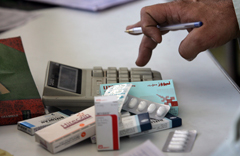
The objective is to provide training in leadership
skills and health information, including adherence
to anti-retroviral treatment.
Photo credit: UNAIDS / J. Moore
The Association has already begun to bring the small number of NGOs and self-help groups together. The objective is to provide training in leadership skills and health information, including adherence to anti-retroviral treatment.
With a Masters in Business Administration from University in Lahore, Masood is working with them to organize themselves strategically, to develop policies and to raise funds.
There has been a three-day workshop on capacity building already, focusing on the issues for people living with HIV in Pakistan and how to operate an effective positive self-help group. Another two-day workshop focused on HIV literacy helped pre-testing and collecting feed back on the newly developed booklets and other information materials produced in Urdu and English for people living with HIV (PLHIV).
UNAIDS will be supporting more workshops across the country and is planning to do this activity in collaboration with Association of PLHIV, provincial and federal Government and civil society organizations working on AIDS issues.
“We aim to contribute to improving people’s lives, give them a sense of belonging, political empowerment and strength of spirit,” says Masood.
At the same time the Association aims to contribute to the national goal – to “prevent a generalized epidemic in Pakistan by containing the spread of HIV and AIDS and elimination of stigma and discrimination against those infected and affected” .
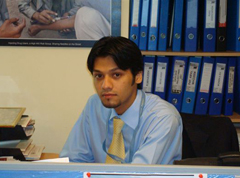
Twenty-four year old Masood is the newest recruit
to one of UNAIDS’ latest initiatives: the“Association
of People Living with HIV and AIDS in Pakistan”.
Photo credit: UNAIDS
*The country's epidemic is concentrated and intensifying. Pakistan has one of the highest rates of injection drug use in the world (4.5 per capita per annum), and 64% of injecting drug users report use of non-sterile needles. Frequent use and reuse of unsterilized and contaminated needles contributes to a high transmission rate of HIV among injecting drug users (10%). The World Health Organisation and UNAIDS estimate the actual prevalence may be as high as 85,000 (46 000- 210 000).
During the Launching ceremony of Association of PLHIV in 1 st December, 2006 Dr. Aldo Landi, UNAIDS Country Coordinator said:
“This is the first step as a breakthrough in the fight against stigma and discrimination”. He further expressed the need of involvement of PLHIV at both federal and provincial level. Most importantly PLHIV should be treated in full respect of human rights.
Masood is a hemophiliac who contracted HIV through infected blood. In Pakistan, about 50 per cent of blood products are screened for HIV before blood transfusion – and 1.5 million blood bags are transfused every year. About 18 per cent of people living with HIV in Pakistan were infected in this way.
“I am very ambitious because I am facing and feeling the pain,”says Masood. “I want to make a real difference by encouraging people living with HIV to realize how important it is for them to be involved at every level.
“They themselves will bring about change. I am happy to be the first drop of rain.”
Links:
More information on Pakistan
Visit UNAIDS Pakistan web site
Read the report - Implementing the UN learning strategy on HIV/AIDS: Sixteen Case Studies

Feature Story
Myanmar: Towards universal access
21 August 2007
21 August 2007 21 August 2007What will it take to reach universal access to HIV prevention, treatment, care and support in Myanmar ? This was the central discussion of a satellite meeting held as part of the 8 th International Congress on AIDS in Asia and the Pacific (ICAAP) on Monday 20 August.
Over the past year the response to AIDS in Myanmar achieved significant progress: a new National Strategic Plan was developed, including the completion of the costed Operational Plan; and in late 2006 the 3-Diseases Fund was launched and became operational in early 2007. “With these key developments, in 2007 there is a real and tangible opportunity to continue to expand the AIDS response in Myanmar with the aim of reaching universal access,” said UNAIDS Country Coordinator, Brain Williams.
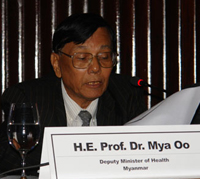
H.E Prof. Dr Mya Oo, Deputy Minister of
Health, Mynmar
Organized by the United Nations Theme Group on AIDS in Myanmar, the satellite session presented an overview of the current epidemic situation; outlined recent gains in the response to AIDS in Myanmar; and highlighted the needs for, and opportunity to, support a further expansion of the response.
Myanmar ’s Deputy Minister of Health Prof. Mya Oo highlighted the country’s commitment to respond to AIDS and outlined efforts underway including the production of a multi-sectoral National Strategic Plan emphasizing reaching out to people most at risk. The Deputy Minister thanked the Three Diseases Fund for their investment in HIV care and prevention services in Myanmar and called for increased resources to be made available to Myanmar to fully enable the response to expand and succeed.
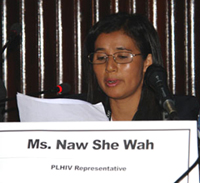
Ms. Naw She Wah, representative of people
living with HIV from Myanmar
The second keynote speaker, representative of people living with HIV Ms. Naw She Wah, spoke of the needs of people living with HIV to have access to treatment, the need for self-help groups to have expanded support including official recognition from the authorities, and called on international organizations to increase their financing to expand coverage beyond the mere 10% of HIV positive people in need of treatment who are currently receiving it.
Technical presentations were made by the National AIDS Programme Manager Dr. Min Thwe, Dr Wiwat Peerapatanapokin an epidemiologist from the East-West Center and recently participated in an HIV prevalence workshop in Myanmar, and Dr. Frank Smithius , Country Representative, MÉdecins Sans Frontières Holland (AZG), Myanmar.
“The session underscored the progress that has been made over recent years in Myanmar in demonstrating that services can be delivered to people in need, but highlighted that low coverage requires increased financial support from international and domestic sources in order to achieve Universal Access,” Brian Williams said.
Links:
Read presentation by Dr Min Thwe, Programme Manager National AIDS Programme Ministry of Health - 'Service coverage for HIV and AIDS Myanmar'
Read presentation by Dr Smithuis, Medicins sans Frontieres Country Representative - 'Prevention and treatment of HIV in Myanmar'
Read presentation by Dr Wiwat Peerapatanapokin, epidemiologist from the East-West Center - 'Progress of HIV Epidemic in Myanmar 2007'

Feature Story
8th International congress on AIDS in ASIA and the Pacific
21 August 2007
21 August 2007 21 August 2007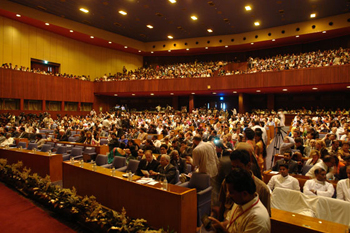
View of the participants attending the opening ceremony at the Bandaranaike Memorial International Conference Hall (BMICH) during the 8th International congress on AIDS in ASIA and the Pacific, Colombo, Sri Lanka19th August 2007
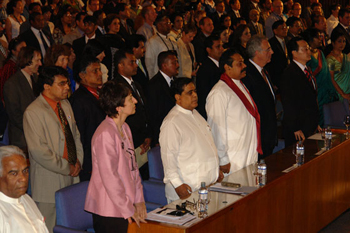
L to R (front row): Ms. Deborah Landey, UNAIDS Deputy Executive Director , Minister Nimal Siripala de Silva, Minister of Healthcare and Nutrition, Sri Lanka, His Excellency Mahinda Rajapakse, President of the Democratic Socialist Republic of Sri Lanka, Michel Kazatchkine, Executive Director, The Global Fund to Fight AIDS, TB & Malaria, Prof. Myung Hwan Cho, President of the AIDS Society of Asia and the Pacific, listening to the national anthem at the opening ceremony of the 8th International congress on AIDS in ASIA and the Pacific, Colombo, Sri Lanka19th August 2007
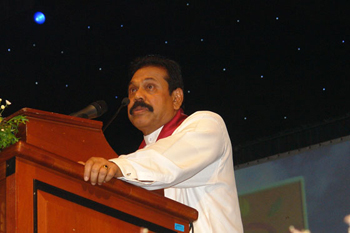
His Excellency Mahinda Rajapakse, President of the Democratic Socialist Republic of Sri Lanka delivering his opening speech at the 8th International congress on AIDS in ASIA and the Pacific, Colombo, Sri Lanka19th August 2007

Ms. Deborah Landey, UNAIDS Deputy Executive Director delivered a speech at the opening ceremony of the 8th International congress on AIDS in ASIA and the Pacific, Colombo, Sri Lanka19th August 2007 on behalf of UNAIDS Executive Director Dr Peter Piot.
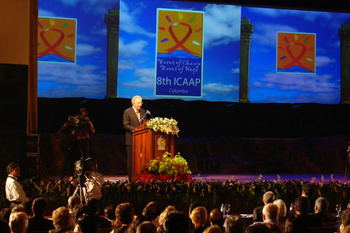
Michel Kazatchkine, Executive Director, The Global Fund to Fight AIDS, TB & Malaria during his intervention at the opening ceremony of the 8th International congress on AIDS in ASIA and the Pacific, Colombo, Sri Lanka19th August 2007

Ms. Deborah Landey, UNAIDS Deputy Executive Director talking to Prof. Myung Hwan Cho, President of the AIDS Society of Asia and the Pacific during the 8th International congress on AIDS in ASIA and the Pacific, Colombo, Sri Lanka19th August 2007
All photo credit: UNAIDS/Noel PELEGRIN
Links:
More on ICAAP

Feature Story
8th International congress on AIDS in Asia and the Pacific
20 August 2007
20 August 2007 20 August 2007Hope for success at ICAAP close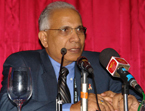 The 8th International Congress on AIDS in Asia and the Pacific (ICAAP) closed with messages of hope for success on moving towards universal access to HIV prevention, treatment, care and support in the region. Speaking at the conference close, UNAIDS Director of the Asia Pacific Regional Support Team, Prasada Rao, acknowledged key progress areas and underlined the need for sustained commitment to AIDS in the region.
The 8th International Congress on AIDS in Asia and the Pacific (ICAAP) closed with messages of hope for success on moving towards universal access to HIV prevention, treatment, care and support in the region. Speaking at the conference close, UNAIDS Director of the Asia Pacific Regional Support Team, Prasada Rao, acknowledged key progress areas and underlined the need for sustained commitment to AIDS in the region.
Read closing remarks by UNAIDS Director of the Asia Pacific Regional Support Team, Prasada Rao
From Kobe to Colombo: Overview of Epidemic and Response in Asia and the Pacific
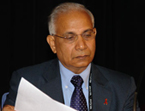
At the plenary of the 8th International Congress on AIDS in Asia and the Pacific, UNAIDS Director of the Regional Support Team for Asia and the Pacific, Prasada Rao gave an overview of developments in the region’s AIDS epidemic and response, examined recent debates that have over strategies and outlined challenges for the future in the region.
Read plenary speech by UNAIDS Director of Asia/PAcific Regional Support Team Prasada Rao
Read press release
Myanmar: Towards universal access
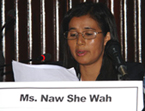 What will it take to reach universal access to HIV prevention, treatment, care and support in Myanmar ? This was the central discussion of a satellite meeting held as part of the 8 th International Congress on AIDS in Asia and the Pacific (ICAAP) on Monday 20 August.
What will it take to reach universal access to HIV prevention, treatment, care and support in Myanmar ? This was the central discussion of a satellite meeting held as part of the 8 th International Congress on AIDS in Asia and the Pacific (ICAAP) on Monday 20 August. Read more
8th International congress on AIDS in ASIA and the Pacific
 The 8th International Congress on AIDS in Asia and the Pacific (ICAAP) takes place in Colombo, Sri Lanka on from 19 - 23 August. The conference brings together more than 3,000 delegates from some 60 countries to discuss critical issues on AIDS in the region such as stigma and discrimination, access to HIV prevention and treatment and the importance of sustained political commitment on AIDS.
The 8th International Congress on AIDS in Asia and the Pacific (ICAAP) takes place in Colombo, Sri Lanka on from 19 - 23 August. The conference brings together more than 3,000 delegates from some 60 countries to discuss critical issues on AIDS in the region such as stigma and discrimination, access to HIV prevention and treatment and the importance of sustained political commitment on AIDS.
Read UNAIDS' opening speech
View photo gallery
 Perspectives on Asia Pacific AIDS conference
Perspectives on Asia Pacific AIDS conference In the run up to the 8th International Congress on AIDS in Asia and the Pacific (ICAAP) which takes place in Colombo, Sri Lanka from 19-23 August 2007, UNAIDS Deputy Executive Director, Deborah Landey and UNAIDS Regional Director for Asia and the Pacific, Prasada Rao, share their hopes and expectations for the conference.
Read more
Listen to interview with UNAIDS Deputy Executive Director, Deborah Landey
8th International congress on AIDS in Asia and th

Feature Story
Perspectives on Asia Pacific AIDS conference
17 August 2007
17 August 2007 17 August 2007
The eighth International Congress on AIDS in Asia and the Pacific (ICAAP) takes place in Colombo, Sri Lanka from 19-23 August 2007. In the run up to the event, UNAIDS Deputy Executive Director, Deborah Landey and UNAIDS Regional Director for Asia and the Pacific, Prasada Rao, share their hopes and expectations for the conference that will host an expected 3,000 participants from some 60 countries throughout the region.
Visions for ICAAP8: Deborah Landey, UNAIDS Deputy Executive Director
Why is this conference important?
I think this conference is extremely important for the world and it’s very important for Asia. Many of the countries in Asia and the Pacific have relatively low prevalence and it’s an opportunity for us to take stock of what’s happening in the region and to come out with the goal of keeping Asia a low prevalence area of the world in terms of AIDS.
What are the focus areas for UNAIDS at this conference?
We are very concerned to emphasize the importance of leadership in responding to the epidemic at all levels—from governments to civil society, all players, actors must be involved.
It’s absolutely vital for countries to ‘know their epidemics’ – and by this we mean really having the most recent, developed data on what is going on with the epidemic in order to be able to use relatively scare resources effectively. In particular we are interested in understanding what we call the ‘drivers of the epidemic’ – the underlying systemic issues such as gender inequality, stigma and discrimination—and getting at these issues so that countries can make fundamental changes to get ahead of their epidemics.
We also want to emphasise that AIDS is going to be with us for a long time to come and therefore the long term agenda and all the issues we need to be thinking about for future generations are extremely important for us to consider here at this meeting.
What can this conference achieve?
If we can get a good analysis and understand what is happening in the region in terms of the epidemic so that we ‘know’ this epidemic in the region, what would be one outstanding outcome. Secondly – we want to know what is happening on the ground, what is working and what is not working? What are the lessons learned, where are we having successes and how can they be replicated? Establishing where the major challenges are will also be a goal.
Visions of Colombo: Prasada Rao, UNAIDS Asia Pacific Regional Director
What’s make the 8 th ICAAP an important meeting?
ICAAP has always been the rallying point for stakeholders such as civil society, people living with HIV, experts, national programme managers, UN partners and donors to focus world’s attention on the special problems of this large region which is home to the 60% of world population. AIDS need to be understood in this specific Asia Pacific context and ICAAP has always provided the best platform for it.
What are the most important issues that are going to be raised and discussed at ICAAP this year?
This ICAAP will specially address the changing AIDS scenario in the region. Recent revision of numbers in some countries has led to a great deal of public and media attention and this is an opportunity to look at the issues squarely and give clarifications. ICAAP will also look at some controversial issues of the moment, such as condom promotion, sex education at school and voluntary testing and counseling, within the Asian context. There will also be clear message about universal access to prevention, treatment, care and support and the need for increased provision of second generation antiretroviral drugs. The Conference also provides a platform for launching two important regional networks of men who have sex with men and sex workers.
What can you tell us about the AIDS epidemic in this region?
The AIDS epidemic in Asia and the Pacific is still increasing and there were approximately 1 million new infections in the last 2 years. Country like Papua New Guinea, Viet Nam Indonesia, Bangladesh and Pakistan are showing an increasing trends of new infections. However, there is good news in some countries. In addition to from Thailand and Cambodia we are seeing a reversal of the epidemic in the southern part of India which has a large population at risk. Infection has remained low in countries like Philippines and Sri Lanka despite large movement of workers for employment outside these countries.
How are countries of Asia and the Pacific scaling up towards universal access to HIV prevention, treatment, care and support?
The universal access agenda has given a great push to the effort of the countries in this region. Based on the political resolution on universal access adopted in UN in June 2007, countries in this region have initiated grassroots planning for setting ambitious target for prevention and treatment. Civil society groups have also enthusiastically participated in this exercise. Today, as many as 16 countries have set universal access targets and nine have prepared national strategic plans and identify resources for implementing them. Asia and the Pacific region can set high standard of achievement for the universal access process.
Links:
Listen to interview with UNAIDS Deputy Executive Director, Deborah Landey
8th International Congress on AIDS in Asia and the Pacific – official web site

